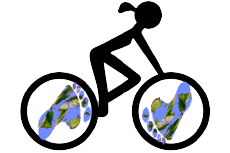
Here's your chance not just to be the mayor, but the original city planner as well! Imagine a medium sized city that would be developed with modern, low carbon transportation in mind, and other strategies to reduce the average citizens' carbon footprints.
What would that city look like? Would that make you more likely to want to live there?
Sustainable City >
Notions of the Future: Sustainable Cities

Sustainable cities are the notions of the future, cities that are delineated to manage the needs of environmental and lucrative impact for the world. Meaning, that these are urban cities that are managed by creating green areas, green neighborhoods, environmental infrastructure, and eco-friendly substitutes to our original ways. Usually, when sustainable cities are spoken about, we usually speak about public transportation, walkable and bikeable neighborhoods, solar panels and farms, green building and architecture, solving our food production processes, easily attainable public resources, the conservation of water, as well as waste management. However, have we ever gotten into the depth of these truly transformative ways to live?
Approximately 1,023 million metric tons of Carbon divide are produced just from U.S gasoline and diesel only. We are speaking about just one single country, one country, the United States. What about the other countries? Combined, this is enough to weaken and allow the carbon dioxide emissions to grow exponentially. 75% of carbon monoxide pollution is created by transportation. Sustainable cities have offered alternatives besides driving individual vehicles, such as metro systems, rail transport, and creating cycling or walkways. Metro systems are rapid transit trains that consist of several cars that are run on the multiple-unit system. Rail transit is one of the fastest forms of ground transportation, using locomotives powered by fuel or electricity. Investments in bike lanes and pedestrian pathways have been encouraged for a number of reasons. Among the most effective modifications that communities can implement to meet their sustainability, economic, and social objectives are walking and bicycling, active transportation, and the lowest carbon forms of transportation.
Green architecture promotes energy efficiency, reuse and security of building materials, the use of renewable energy sources, and their need to lower the negative environmental effects. For instance, buildings such as One Central Park in Sydney, Australia. Once Central Park has 35,000 green wall plants inside it. They prioritize saving and reuse wastewater for irrigation and waste. These smart designs ensure to create structures that benefit the environment and communities of the world. Tao Zhu Yin Yuan in Taiwan has an “Anti-Global Warming and Carbon-Absorbing Ecosystem” according to Amazing Architecture.
We have time, we still do. So many years have passed and we state that we will do something but we usually don’t. If the world eventually burns out due to everything we have done, who will tell our story? We’re running out of time, we have a limit, so what can we still do? What can we do while we have more time? We may start fixing the globe by fixing the large cities where we reside and the ones that are often traversed by cars. Have we done enough yet? No, we haven't. We have to press forward. We are paving the path to reject waste and significant carbon emissions from the world we live in by creating sustainable cities.





